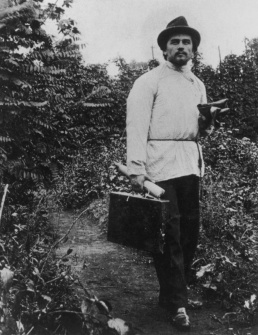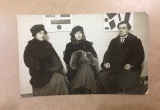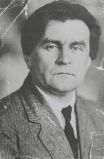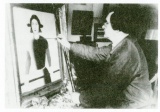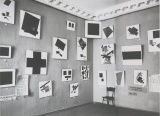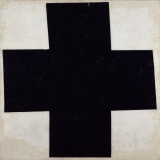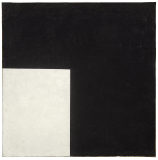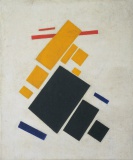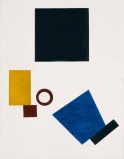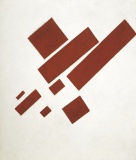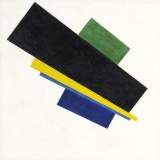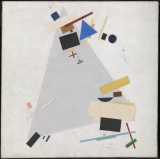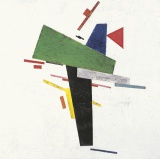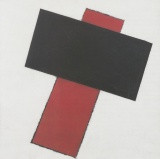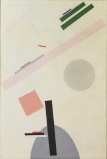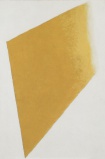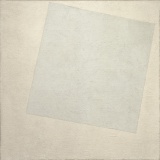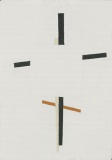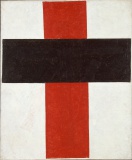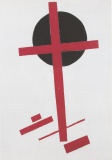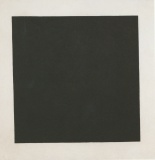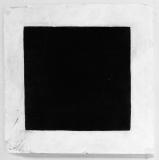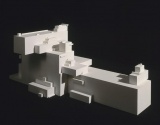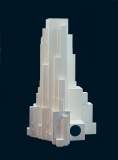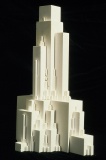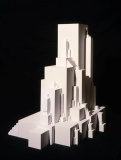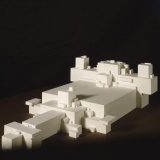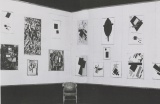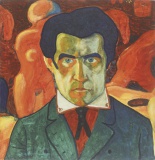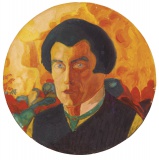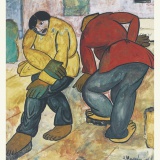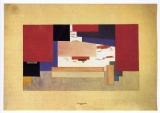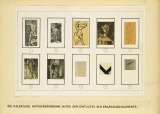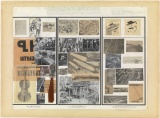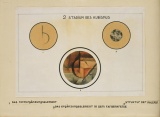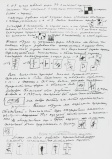Kazimir Malevich
 Malevich with his paintings in Leningrad, 1924. | |
| Born |
February 23, 1879 near Kiev, Russia (now Ukraine) |
|---|---|
| Died |
May 15, 1935 (aged 56) Leningrad, Soviet Union |
| Collections | Stedelijk 29+198, Tretyakov 12, MoMA 7+38, Costakis, Pompidou 4+6+19, Moderna Museet 2, Guggenheim 2, Tate 2, Artic 1+9, State Russian M 1, Wilhelm Hack 1, NGA Canberra 1, Thyssen 0+1, RGALI |
Kazimir Severinovich Malevich (Казимир Северинович Малевич, Kazimierz Malewicz, 1879–1935) was a Polish-Russian painter and art theoretician. He was a pioneer of geometric abstract art and the originator of the Suprematist movement.
Life and work
Born 1879 near Kiev to ethnic Poles as the first of 14 children, he is baptised in the Roman Catholic Church. His father manages a sugar factory. Family moves often and he spends most of his childhood in the villages of Ukraine amidst sugar-beet plantations, far from centers of culture. 1895-96 studies drawing in Kiev.
1896-1904 lives in Kursk. 1904 moves to Moscow after the death of his father. 1904-10 studies at the Moscow School of Painting, Sculpture and Architecture, and in the studio of Fedor Rerberg in Moscow. 1911 participates in the second exhibition of the group Soyuz Molodyozhi (Union of Youth) in St Petersburg, together with Tatlin; 1912 at the group's third exhibition along the works by Ekster, Tatlin and others. 1912 participates in an exhibition by the collective Donkey's Tail in Moscow. By that time his works were influenced by Natalia Goncharova and Mikhail Larionov. 1912 shows the first time outside Russia, at the Blaue Reiter Exhibition. March 1913 a major exhibition of Aristarkh Lentulov's paintings in Moscow, Malevich absorbs the cubist principles. 1913 well-received Cubo-Futurist opera Victory Over the Sun with Malevich's stage-set. 1914 exhibits in the Salon des Independants in Paris with Archipenko, Delaunay, Ekster and Meller, among others.
1915 lays down the foundations of Suprematism in manifesto From Cubism to Suprematism. 1915 paints Black Square. 1915–1916 works with other Suprematist artists in a peasant/artisan co-operative in Skoptsi and Verbovka village. 1916–1917 participates in exhibitions of the Jack of Diamonds group in Moscow together with Altman, Burliuk and Ekster, among others. 1918 paints White on White. 1918 decorates a play, Mystery Bouffe, by Mayakovsky produced by Meyerhold. Interested in aerial photography and aviation, which leads him to abstractions inspired by or derived from aerial landscapes.
1918-19 a member of the Collegium on the Arts of Narkompros, the Commission for the Protection of Monuments and the Museums Commission. 1919-22 teaches at the Vitebsk Practical Art School where he leads the UNOVIS group; 1922-27 at the Leningrad Academy of Arts; 1927-29 at the Kiev State Art Institute; 1930 at the House of the Arts in Leningrad. 1926 his book The World as Non-Objectivity is published in Munich, only translated into English in 1959; where he outlines his Suprematist theories. 1923 appointed director of Petrograd State Institute of Artistic Culture, which is forced to close in 1926 after a Communist party newspaper called it "a government-supported monastery" rife with "counterrevolutionary sermonizing and artistic debauchery." Summer 1925 meets Eisenstein for the first time, in the village of Nemchinovka, outside Moscow, where Malevich used to spend the summers since the early 1910s. 1925-26 publishes three essays on film in the 'Film Journal ARK', calling for a new language of experimental film to evolve from fine art, as opposed to the traditional sources, photography and theatre. 1927 travels to Warsaw, then to Berlin (29 March-5 June) and Munich for a retrospective which finally brings him international recognition. At his own request, he is introduced by Alexander von Riesen, his escort in Berlin, to Hans Richter. Arranges to leave most of the paintings behind when he returns to the Soviet Union. Stalinist regime turns against forms of abstraction, considering them a type of "bourgeois" art, that could not express social realities; many of his works were confiscated and he is banned from creating and exhibiting similar art. Quietly tolerated by the Communists. Died of cancer in 1935 in Leningrad.
Portraits
Olga Rozanova, Ksenia Boguslavskaia, and Kazimir Malevich seated in front of Malevich's Suprematist paintings at the 0.10 exhibition, Petrograd, 1915.
Works
Suprematism
A section of works by Malevich displayed at 0.10, showing 21 of the 39 paintings listed in the catalogue.
Chernyy suprematicheskiy kvadrat [Черный супрематический квадрат; Black Suprematic Square], 1915. Oil on canvas. 79,5 х 79,5 cm. Tretyakov.
Chernye krestoobraznye ploskosti [Cross (Black)], 1915. Oil on canvas. 80 x 80 cm. Pompidou.
Black and White. Suprematist Composition, 1915. Oil on canvas. 80 x 80 cm. Moderna Museet.
Suprematizm: Aeroplan letit [Suprematist Composition: Airplane Flying], 1915. Oil on canvas. 58.1 x 48.3 cm. MoMA.
Zhivopisnyi realizm mal'chika s rantsem--krasochnye massy v 4-m izmerenii [Painterly Realism of a Boy with a Knapsack Color Masses in the Fourth Dimension], 1915. Oil on canvas. 71.1 x 44.5 cm. MoMA.
Suprematizm (Avtoportret v dvukh izmereniiakh [Suprematism (Self-Portrait in Two Dimensions)], 1915. Oil on canvas. 80 x 62 cm. Stedelijk.
Suprematicheskaia kompozitsiia [Suprematist Composition (With Eight Rectangles)], 1915. Oil on canvas. 57,5 x 48,5 cm. Stedelijk.
Zhivopisnyi realizm futbolista krasochnye massy v 4-m izmerenii [Painterly Realism of a Football Player - Color Masses in the 4th Dimension], summer/fall 1915. Oil on canvas. 71 x 44.5 cm (original); 70.2 x 44.1 cm (present). Artic.
Stroyuschiysya dom [House under Construction], 1915-16. Oil on canvas. 97 cm x 44,5 cm. NGA Canberra.
Dynamic Suprematism, 1915-16. Oil paint on canvas. Support: 80,3 x 80 cm, frame: 101,5 x 101,5 x 8 cm. Tate.
Untitled (Compact Magnetic Cluster), 1916. Oil on canvas. 53 x 53 cm. Guggenheim.
Suprematism, 1915-16. Oil on canvas. 87.5 x 72 cm. Russian State M.
Suprematist Painting, 1916-17. Oil on canvas. 97.8 x 66.4 cm. MoMA.
Suprematist Painting (Yellow Plane in Dissolution), 1917-18. Oil on canvas. 106.5 x 70.5 cm. Stedelijk.
Suprematicheskaia kompozitsia: beloe na belom [Suprematist Composition: White on White], 1918. Oil on canvas. 79.4 x 79.4 cm. MoMA.
Suprematia of the Spirit, 1920. Oil on canvas. Stedelijk.
Hieratic Suprematist Cross (Large Cross in Black Over Red on White), 1920-21. Stedelijk.
Mystic Suprematism (Red Cross on Black Circle), 1920-22. Stedelijk.
Black Square, c1923. Oil on canvas. 106 x 106 cm. State Russian M.
Black Square, 1923-30. Oil on plaster. 36,7 x 36,7 x 9,2 cm. Pompidou.
Other
Self-Portrait, 1908-10. Gouache and watercolour on paper. 27 х 26,8 cm. Tretyakov.
Floor Polishers, 1911. Gouache on paper. 77,7 x 71 cm. Stedelijk.
With El Lissitzky, Study for Backcloth for Vitebsk Committee for the Struggle against Unemployment, 1919.
Writings
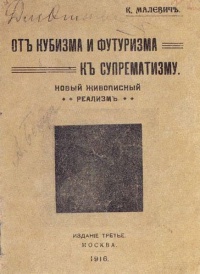

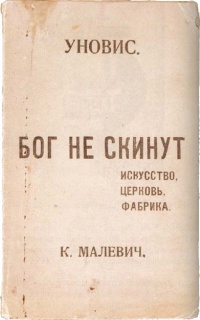
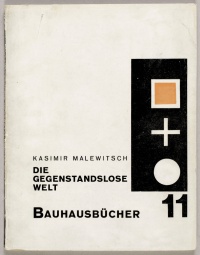
- Ot kubizma k suprematizmu. Novyi zhivopisnyi realizm [От кубизма к супрематизму. Новый живописный реализм], Petrograd, Dec 1915; 2nd ed., Petrograd, January 1916; 3rd ed. as Ot kubizma i futurizma k suprematizmu. Novyi zhivopisnyi realizm [От кубизма и футуризма к супрематизму. Новый живописный реализм], Moscow, Nov 1916. (Russian)
- "From Cubism and Futurism to Suprematism: The New Painterly Realism", trans. of 3rd ed., in Russian Art of the Avant-Garde: Theory and Criticism, 1902-1934, ed. & trans. John E. Bowlt, New York: Viking Press, 1976, pp 116-135, n303. (English)
- Del cubismo al suprematismo: el nuevo realismo pictórico, intro. Luis Cardoza y Aragón, México, D.F.: Grijalbo, 1975, 216 pp. (Spanish)
- "Suprematizm", in X Gosudarstvennaya vystavka. Bespredmetnoe tvorchestvo i suprematizm, Moscow, 1919. (Russian)
- "Suprematism", in Russian Art of the Avant-Garde: Theory and Criticism, 1902-1934, ed. & trans. John E. Bowlt, New York: Viking Press, 1976, pp 143-145, n304. (English)
- Ot Sezanna do Suprematizma. Kriticheskiy ocherk [От Сезанна до Супрематизма: Критический очерк], Moscow: Narkompros, 1920, 16 pp. [6] (Russian)
- Bog ne skinut. Iskusstvo, tserkov’, fabrika, 1922. [7] (Russian)
- Die gegenstandslose Welt, Munich: A. Langen [Bauhausbuch 11), 1927, 104 pp; new ed., exp., Mainz: Florian Kupferberg, 1980. Russian original written in 1923. (German)
- The Non-Objective World, trans. Howard Dearstyne, Chicago: P. Theobald, 1959, 102 pp. (English)
- Nepredmetni svijet, trans. Nenad Popović and Snješka Knežević, Zagreb: Centar za kulturnu djelatnost & Galerija Nova, 1981. Trans. of the 1980 German edition. (Serbo-Croatian)
- Mutaishō no sekai, trans. Omuka Toshiharu, Tokyo: Chūō Kōron Bijutsu Shuppan, 1992, 170 pp. (Japanese)
- El Mundo no objetivo, trans. Juan Pablo Larreta Zulategui, Sevilla: Doble J, 2007, 109 pp. (Spanish)
- Suprematismus: die gegenstandslose Welt, ed. Werner Haftmann, trans. Hans von Riesen, Cologne: DuMont Schauberg, 1962, 286 pp; unchanged repr., 1989. (German)
- Suprematismo: il mondo della non-oggettività, trans. Franco Rosso, Bari: De Donato, 1969, 271 pp. (Italian)
- N. Khardzhiev, Kazimir Malevich, Mikhail Matiushin, The Russian Avant-Garde / K istorii russkogo avangarda, Stockholm: Hylaea Prints, 1976, 189 pp. (English)/(Russian)
- "Chapters from an Artist's Autobiography", trans. Alan Upchurch, October 34 (Fall 1985), pp 25-44. (English)
Articles on film
- "On Exposers. Posters" (1925), in The White Rectangle: Writings on Film, ed. Oksana Bulgakowa, Potemkin Press, 2002. (Russian)/(English)
- "I likuyut liki na ekranakh" [И ликуют лики на экранах; And Images Triumph on the Screen], Киножурнал АРК 10 (1925), pp 8-9. Compares Vertov and Eisenstein. (Russian)
- "And Visages Are Victorious on the Screen", in The White Rectangle: Writings on Film, ed. Oksana Bulgakowa, Potemkin Press, 2002. (Russian)/(English)
- "Khudozhnik i kino" [Художник и кино], Киножурнал АРК 2 (1926). (Russian)
- "The Artist and the Cinema", in The White Rectangle: Writings on Film, ed. Oksana Bulgakowa, Potemkin Press, 2002. (Russian)/(English)
- "Zhivopis' i problemy arkhitekturnogo priblizheniya novoy klassicheskoy arkhitekturnoy sistemy" [Живопись и проблемы архитектурного приближения новой классической архитектурной системы], 1927, 3 pp. (Russian) First printed as a facsimile with a French translation in C. Czwiklitzer, Lettres autographes des peintures et sculptures, Basle, 1976, pp 487-488. Russian version repr. as "Художественно-научный фильм Живопись и проблемы архитектурного приближения новой классической архитектурной системы", in Malevich, Классический авангард 3, ed. А.С.Шатских, Vitebsk: Сб; ed. Т.В.Котович. Vitebsk: Областной краеведческий музей, 1999. pp 33-40. A script for an "artistic-scientific film", in manuscript. After seeing Hans Richter's film in Berlin in 1927, Malevich hoped to get assistance from him. The script was lost until the late 1950s. In 1970, Richter began to make an animation based on Malevich's script but the project was left unfinished. [8]
- "Art and the Problems of Architecture. The Emergence of a New Plastic System of Architecture", in The White Rectangle: Writings on Film, ed. Oksana Bulgakowa, Potemkin Press, 2002. (Russian)/(English)
- "[Painting and Photography]. A Letter to Laszlo Moholy-Nagy" (1927), in The White Rectangle: Writings on Film, ed. Oksana Bulgakowa, Potemkin Press, 2002. (Russian)/(English)
- "Kino, grammofon, radio i khudozhestvennaya kul'tura" [Кино, граммофон, радио и художественная культура], early 1928. (Russian) Manuscript. First printed in Malevich, vol. IV, ed. Troels Andersen, pp 163-176. [9]
- "Cinema, Gramophone, Radio, and Artistic Culture", in The White Rectangle: Writings on Film, ed. Oksana Bulgakowa, Potemkin Press, 2002. (Russian)/(English)
- "Zhivopisnye zakony v problemakh kino" [Живописные законы в проблемах кино], Kino i kul'tura [Кино и культура] 7-8 (1929), pp 22-26. (Russian)
- "Painterly Laws in the Problems of Cinema", trans. Cathy Young, in Margarita Tupitsyn, Malevich and Film, Yale University Press, 2002, pp 147-159. (English)
- "Pictorial Laws in Cinematic Problems", in The White Rectangle: Writings on Film, ed. Oksana Bulgakowa, Potemkin Press, 2002. (Russian)/(English)
Collected writings
- Essays on Art 1915-1933, 2 vols., ed. Troels Andersen, trans. Xenia Glowacki-Prus and Arnold McMillin, London: Rapp & Whiting, 1969, 259 pp; 2nd ed., New York: G. Wittenborn, New York, 1971. (English)
- Écrits, ed. Andrei B. Nakov, trans. Andrée Robel-Chicurel, Paris: Champ libre, 1975, 450 pp. (French)
- The World as Non-Objectivity: Unpublished Writings 1922-25, ed. Troels Andersen, Copenhagen, 1976. (English)
- The Artist, Infinity, Suprematism: Unpublished Writings 1913-33, ed. Troels Andersen, trans. Xenia Hoffman, Copenhagen: Borgen, 1978, 260 pp. (English)
- Das weisse Rechteck: Schriften zum Film, ed. Oksana Bulgakowa, Berlin: Potemkin Press, 1997, 154 pp. (German)/(Russian)
- Sobranie sochineniy v pyati tomakh [Собрание сочинений в пяти томах; Collected Writings in 5 Volumes], Moscow: Gileya, 1995-2004. (Russian)
- 1. Статьи, манифесты, теоретические сочинения и другие работы. 1913—1929, 1995, DJVU. [11]
- 2. Статьи и теоретические сочинения, опубликованные в Германии, Польше и на Украине. 1924-1930, 1998.
- 3. Супрематизм. Мир как беспредметность, или Вечный покой, 2000, DJVU.
- 4. Трактаты и лекции первой половины 1920-х годов. С приложением переписки К.С. Малевича и Эль Лисицкого (1922-1925), 2003, DJVU.
- 5. Произведения разных лет. Статьи. Трактаты. Манифесты и декларации. Проекты. Лекции. Записи и заметки. Поэзия, 2004, DJVU. [12]
- Chernyy kvadrat [Черный квадрат], Moscow: Azbuka, 2001, HTML. (Russian)
- Suprematické zrcadlo. Texty k bezpředmětnosti, ed. & trans. Tomáš Glanc, Prague: Brody, 1999, 201 pp. (Czech)
Catalogues
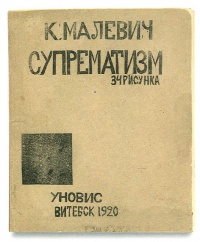
- Suprematizm. 34 risunka, Vitebsk: Unovis, 1920. [13] (Russian)
- Kazimir Malevich 1978-1935, ed. Jeanne D'Andrea, Los Angeles: The Armand Hammer Museum of Art and Cultural Center, 1990. (English)
- Malevich. Colección del Museo estatal ruso, San Petersburgo, Madrid: Fundación Juan March, 1992, 108 pp. [14] (Spanish)
- Suprematism, ed. Matthew Drutt, New York: Guggenheim Museum, 2003, 272 pp. With essays by Matthew Drutt, Nina Gurianova, Jean-Claude Marcadé, Tatiana Mikhienko, Evgenia Petrova, and Vasilii Rakitin. [15]
- Nas budet troe, Moscow: Sepherot Foundation, 2012.
- Linda S. Boersma, Bart Rutten, Sophie Tates, Aleksandra Shatskikh, Kazimir Malevich and the Russian Avant-Garde. Featuring Selections from The Khardzhiev and Costakis Collection, Walther König, 2013, 240 pp. [16] [17] [18]
- Kazimir Malevich en de russische avant-garde, Walther König, 2013, 236 pp. [19] (Dutch)
- Catalogues raisonné
- Malevich: Catalogue Raisonné of the Berlin Exhibition 1927, Including the Collection in the Stedelijk Museum Amsterdam, ed. Troels Andersen, Stedelijk Museum, 1970, 168 pp.
- Andrei Nakov, Kazimir Malewicz, Catalogue Raisonné, Paris: Adam Biro, 2002. (French)
Literature
Monographs
- Larissa A. Schadowa, Suche und Experiment: aus der Geschichte der russischen und sowjetischen Kunst zwischen 1910 und 1930, trans. Helmut Barth, Dresden: Verlag der Kunst, 1978, 371 pp. (German)
- L. Zhadova, Malevich: Suprematism and Revolution in Russian Art, 1910–1930, trans. Alexander Lieven, London: Thames and Hudson, 1982, 371 pp. (English)
- Charlotte Douglas, Swans of Other Worlds: Kazimir Malevich and The Origins of Abstraction in Russia, Ann Arbor, MI: UMI Research Press, 1980, xii+147 pp. (English)
- Rainer Crone, David Moss, Kazimir Malevich: The Climax of Disclosure, Reaktion Books, 1991, 237 pp; 2014, 320 pp. [20] [21] [22] (English)
- Dmitrii Sarabyanov (Дмитрии Сарабьянов), Alexandra Shatskikh (Александра Шатских), Kazimir Malevich: Zhivopis. Teoriya [Казимир Малевич: Живопись. Теория], Moscow: Iskusstvo, 1993, 414 pp. (Russian)
- Aleksandra Shatskikh (Александра Шатских), Kazimir Malevich [Казимир Малевич], Moscow: Slovo, 1996, 96 pp. (Russian)
- John Milner, Kazimir Malevich and the Art of Geometry, Yale University Press, 1996, 248 pp. [23] (English)
- Margarita Tupitsyn, Malevich and Film, Yale University Press, 2002, 192 pp. With essays by Kazimir Malevich and Victor Tupitsyn. TOC, [24]. Reviews: Witkovsky (CAA 2003), Minturn (AJ 2004). (English)
- Charlotte Douglas, Christina Lodder (eds.), Rethinking Malevich: Proceedings of a Conference in Celebration of the 125th Anniversary of Kazimir Malevich’s Birth, London: Pindar Press, 2007, 381 pp. (English)
- Aleksandra Shatskikh (Александра Шатских), Kazimir Malevich i obshchestvo Supremus [Казимир Малевич и общество Супремус], Moscow: Tri kvadrata, 2009, 464 pp. (Russian)
- Constructivism in Europe: From Malevich to Kandinsky, Beijing: Art Museum of China, 2012. (English)
- Aleksandra Shatskikh, Black Square: Malevich and the Origin of Suprematism, trans. Marian Schwartz, Yale University Press, 2012, 320 pp. (English)
Book chapters, papers, articles
- Branislav Jakovljevic, "Unframe Malevich!: Ineffability and Sublimity in Suprematism", Art Journal 63:3 (Autumn 2004), pp 18-31. (English)
- "Malevich, Kazimir Severinovich", Oxford Art Online, n.d. (English)
Theses
- Tarcisio Cardoso, Suprematism-as-architecture : opening the way to K. Malevich's work, McGill University School of Architecture, 1993. Thesis.
- Catherine I. Kudriavtseva, The making of Kazimir Malevich's Black square, University of Southern California, 2010. Ph.D. Dissertation.
See also
Links
- http://www.kazmalevich.info (Russian)
- Biography and works
- List of Suprematist paintings by Malevich
- Video
- "Malevich’s Burial Site Is Found, Underneath Housing Development", August 2013.
- The Malevich Archive in the Stedelijk Museum, Amsterdam.
- Malevich at Wikipedia
- http://users.i.com.ua/~lak/russian/film-malevich.htm
- Nemchinovka-Malevich
- http://www.kasimirmalevich.org/
